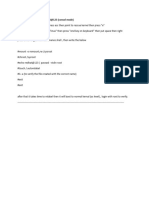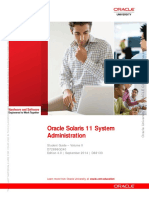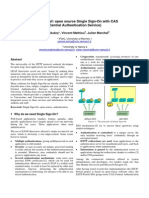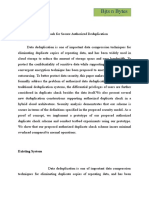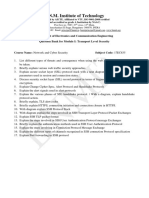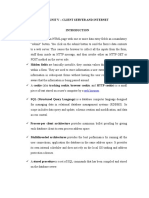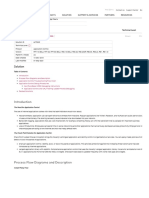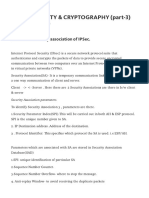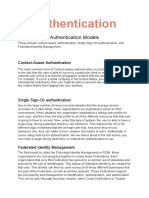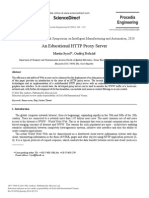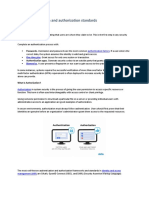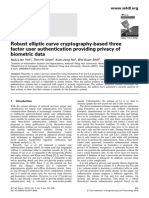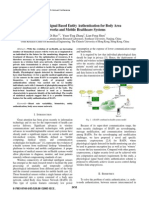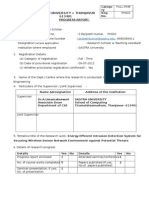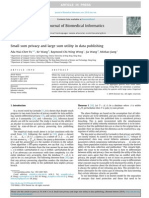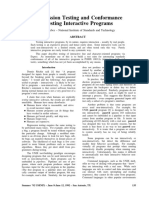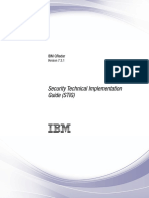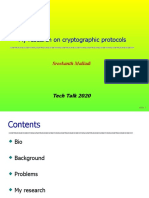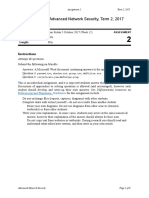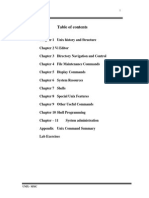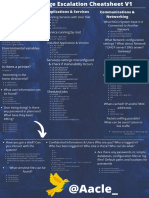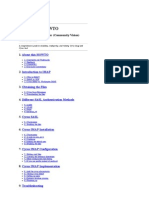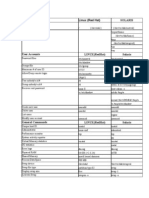Extending SIP Authentication To Exploit User Credentials Stored in Existing Authentication Databases
Extending SIP Authentication To Exploit User Credentials Stored in Existing Authentication Databases
Uploaded by
jayaCopyright:
Available Formats
Extending SIP Authentication To Exploit User Credentials Stored in Existing Authentication Databases
Extending SIP Authentication To Exploit User Credentials Stored in Existing Authentication Databases
Uploaded by
jayaOriginal Description:
Original Title
Copyright
Available Formats
Share this document
Did you find this document useful?
Is this content inappropriate?
Copyright:
Available Formats
Extending SIP Authentication To Exploit User Credentials Stored in Existing Authentication Databases
Extending SIP Authentication To Exploit User Credentials Stored in Existing Authentication Databases
Uploaded by
jayaCopyright:
Available Formats
Extending SIP Authentication to exploit user credentials
stored in existing authentication Databases
Stefano Salsano(1), Andrea Polidoro(1), Luca Veltri(2)
(1)
DIE, University of Rome Tor Vergata- Italy
Dpt. Information Engineering, University of Parma - Italy
E-mail: stefano.salsano@uniroma2.it, andrea.polidoro@uniroma2.it, luca.veltri@unipr.it
(2)
Abstract: The SIP protocol provides authentication and
authorization of SIP requests through a challenge-response
authentication scheme inherited by the HTTP protocol and
named HTTP Digest Authentication. The current specification
defines a particular algorithm for calculating the challenge
response that uses the MD5 hash of a combination of user name,
realm, and password. Unfortunately, a lot of authentication
systems maintain the user credentials protected with a one-way
function (usually a hash) in a way that is incompatible with the
information required by the current HTTP Digest
Authentication. Some examples are given by the mechanisms
used for storing passwords by the Unix OS, LDAP servers, or
other applications. In this paper, we propose to extends the
original HTTP Digest Authentication by adding a new and
flexible scheme that uses an arbitrary hash function and an
arbitrary combination of various information such as user
name, realm, password, salt, and/or other data. The proposed
authentication scheme has been implemented within two
testbeds in which a SIP UA authenticates itself with a remote
proxy server (acting as authenticator) that uses respectively a
LDAP server or a users' password file of a Joomla Content
Management System.
1. INTRODUCTION
The SIP (Session Initiation Protocol) [1] is the IETF standard
for setting-up, maintaining, and tearing-down peer-to-peer
sessions between two or more user agents (UAs). SIP is
currently used as standard signaling protocol for VoIP
(Voice-over-IP), Instant Messaging (IM), and conferencing
applications, and has been adopted by the 3GPP (Third
Generation Partnership Project) as standard signaling
protocol for real-time applications within the IP Multimedia
Subsystem (IMS) of the third generation mobile networks
(UMTS) [3].
As specified in RFC3261 [1], SIP uses the HTTP Digest
Authentication mechanism for authenticating and authorizing
the
users.
The
SIP
servers
that
perform
authentication/authorization usually access a database with
the credential of the users. This database of credential can
either store the clear text password (rarely used for security
risks) or a non-revertible hash of the password, using a
mechanism coherent with that used by the HTTP Digest
This work has been partially supported by the Italian Ministry for
University and Research (MIUR) within the project PROFILES under the
PRIN 2006 research program.
Authentication.
The
problem
is
that
with
other
user
authentication/authorization mechanisms different and non
compatible mechanisms are used to store non-revertible
hashes of the password. This prevents reusing an existing
database of user credentials to offer SIP based services.
Examples of password storing mechanisms that are not
compatible with the SIP Digest Authentication are those used
by: i) LDAP server, ii) UNIX with shadow/password file, iii)
Apache (and other systems) with htpasswd file, iv) SQL
database.
Therefore at the current state of the art, if someone wants to
offer SIP services to a community of users that is
authenticated using one of the four mechanisms shown
above, a different SIP specific database of credentials need to
be realized. This may pose some logistic problems and create
user discomfort.
For this reason, in this paper we propose a set of
authentication mechanisms for SIP that extend the one
specified in RFC 3261 [1]. These algorithms use specific
hash algorithms and a combination of various data such as
user name, real, password, salt, and/or other information, in
order to interoperate with the storage of credentials in
existing authentication/authorization mechanisms.
This work was driven by two specific application scenarios
that we had to face. The first scenario was a Wireless VoIP
application, to be realized on top of an already realized WiFi
authentication infrastructure. The WiFi authentication
infrastructure relied on LDAP servers for storing the
password and a set of users was already in the LDAP
database. The advantage of reusing the same authentication is
evident.
The second scenario relates to a research project named
Simple Mobile Services (founded by the EC) [2]. In this
project we have developed a communication middleware
based on SIP [10] to exchange messages among a set of
mobile terminals and servers. In order to provide web based
interaction a web portal is realized using the open source
Content Management System (CMS) Joomla. Each user
needs to be authenticated and authorized to access services on
the Joomla web portal. At the same time the users mobile
terminal uses a SIP UA that needs to be authenticated in
order to use the middleware facilities and be able to
send/receive messages. It was again natural to desire a single,
integrated handling of user credential, and in particular to re-
use the sophisticated user management system of a CMS like
Joomla.
First in section 2 a brief description of the HTTP digest
authentication used in SIP is provided, then in section 3 the
proposed solution is described, with a discussion on how the
solution has been chosen among some alternatives. Section 4
provides a description of the implementation, and finally
some conclusions are drawn in section 5.
2. HTTP DIGEST AUTHENTICATION FOR SIP
SIP is a text-based protocol with a syntax very similar to
HTTP and, like HTTP, it uses a client-server model based on
request-response transactions. SIP requests are exchanged
between a SIP user agent client (UAC) and a SIP user agent
server (UAS), or between a UAC and an intermediate SIP
proxy. The SIP authentication procedure specified in [1] is
derived from HTTP Digest Authentication [4]. It is a general
challenge-response mechanism in which a UAS authenticates
a UAC based on a shared secret. The challenge response is
computed through the use of a one-way function based on
various users credentials. The standard also specifies the use
of a particular function (in turn based on the MD5 hash
function) that requires that both the client and server knows
the user secret (normally a password) or, at least, the hash of
the concatenation of the user name, the realm, and the
password.
UAC
UAS
Register
digest algorithm applied to "data", and A1 is a quantity that
should take into account user credentials.
As specified in [4], by default or in case of
algorithm=MD5, KD(,) H(), and A1 are respectively:
KD(secret, data) = MD5(secret:data))
H(data) = MD5(data)
A1 = username:realm:passwd
Particularly, the first term of KD(,) (indicated as secret)
and computed as H(A1) becomes:
secret = H(A1) = MD5(username:realm:passwd)
Note that both the requestor (the UAC) and the server do not
need to know the user password, but rather this secret i.e. a
digest function of username, realm and password itself: in
order to correctly compute the response the UAC and the
UAS need only to be able to calculate or retrieve from an
archive the value MD5(username:realm:passwd).
3. NEW EXTENSIBLE AUTHENTICATION SCHEME
The HTTP Digest Authentication specified in [4] and
described in the previous section requires that the response to
the challenge, regardless of the selected algorithm, is in the
form of:
response = KD(H(A1), nonce:nc:cnonce:qop:H(method:uri))
Since both the UAC and the UAS have to calculate such
response value, they both have to be able to access users
credentials or, at least, the quantity H(A1). that in case of
algorithm=MD5 is:
H(A1) = MD5(username:realm:passwd)
401 Antauthorized
Register
200 OK
Figure 1 The SIP digest authentication
A representation of this authentication procedure is given in
Figure 1.
The challenge and response values are respectively inserted
in the WWW-Authenticate header field (Proxy-Authenticate
header for proxy authentication) of the response message sent
by the UAS, and the Authorization header field (ProxyAuthorization header for proxy authentication) of the new
request message sent by the UAC. According to [4] the
response is computed as:
response = KD(H(A1), nonce:nc:cnonce:qop:H(method:uri))
where KD(secret,data) is a general two-parameters digest
algorithm applied to "data" with secret "secret", H(data) is a
Unfortunately several authentication systems are not
compatible with this way of sending the user credentials in a
digested form. At the contrary they use different hashing
algorithms with different parameters. In this section we
discuss some options on how to define authentication
algorithms that are compatible with existing authentication
systems and how to extend SIP signaling to this purpose.
Let us start from the definition of the algorithms. Assuming
for the moment that we have no interest in changing the KD
function, we can envisage two possible solutions:
a) we can define a different A1 and H(A1) function
compatible with the specific authentication system (A1 is a
formatted set of parameters that are taken into account by the
H() function). For example A1 could be the concatenation
passwd:salt and H(A1) could become:
H(A1) = MD5(passwd:salt)
b) we can reuse the definition of H(A1) and only replace the
password parameter with a new derived pseudo-password A3
defined as A3=KP(password,other-params). In this case we
are introducing a new function KP() with a new set of
parameters that includes the user password. The value A1
becomes: A1=username:realm:A3.
For example, if we chose KP() as MD5(passwd:salt) the
value H(A1) becomes:
H(A1) = MD5(username:realm:A3) = H(A1) =
= MD5(username:realm:MD5(passwd:salt))
The first solution (a) has the advantage that it may save some
computation of crypto functions. The second option (b) has
the advantage that it inherits all the security properties of the
current MD5 solution specified for HTTP Digest
Authentication. Moreover one could store in the client the
derived password (i.e. the A3 value) instead of the password
and maintain a compatibility with existing clients. The A3
value could be computed externally and then manually stored
in the SIP client. Of course this is not our suggested solution,
i.e. we believe that SIP stacks should be enhanced with the
proposed solution so that SIP UA can natively support the
new authentication method, anyway it was worth mentioning
this possibility to reuse legacy clients in the short term.
Once that we have chosen which solution for the algorithm,
we should discuss: 1) how to introduce the indication of this
different authentication algorithms within SIP signaling; 2)
how to convey the parameters that are needed by the new
authentication algorithms. Again, we introduce two different
options concerning issue 1):
i) introduce new algorithms specified as parameter
algorithm within authentication headers. We could have for
example algorithm=md5-ldap-sha1, algorithm=md5-cryptdes and so on.
ii) introduce a new authentication parameter called pwdalgo in order to indicate the chosen algorithm used to
compute only the derived-passwd A3.
These two choices are not completely independent from the
choice of the algorithm definition, as shown in the following
table.
i) introduce new values
for the algorithm
parameter
ii) introduce a new pwdalgo parameter
a) definition of a new A1
and H(A1)
Yes
No
b) reuse H(A1) with new
A3 value in place of
passwd
Possible
Suggested
If we define new A1 and H(A1) this should be signaled by
introducing new values for the algorithm parameter. At the
contrary, if we reuse H(A1) and introduce A3=KP() in place
of the clear password, both options for the signaling are
feasible, but we think that keeping the algorithm parameter
unchanged (that specify A1, H(), and KD()) and introducing a
new pwd-algo is preferable.
Now we finally need to discuss how to convey the additional
parameter that may be needed by the different authentication
mechanisms. We think that three options are possible:
1) introduce new parameters with specific names for each
authentication algorithm;
2) introduce a generic parameter named pwd-param to carry
algorithm specific parameters;
3) carry the new parameters added inside the nonce
parameter. This is the approach that has been followed for
example in the specification of the AKA authentication
mechanism [5].
We believe that 1) is the worst solution as it may lead to add
several new parameters. 2) and 3) are both feasible, where 2)
is a cleaner approach that requires the definition of an
additional parameter, while 3) has the advantage that does not
require any new parameter.
Considering the various discussed options, a first possible
solution is based on: a) reuse of H(A1) with a modified
version of A1 in which the password value is simply replaced
by A3 = KP(password,other-params), b) introduction of new
pwd-algo parameter, and c) introduction of a new generic
pwd-param parameter. Examples of the new pwd-algo
parameter are:
pwd-algo=ssha
pwd-algo= crypt-md5
pwd-algo= crypt-apache
A second possible solution, more conservative from the point
of view of SIP signaling is the use of A3 =
KP(password,other-params) as above, but specifying the
chosen algorithm in the existing algorithm parameter and
carrying the algorithm specific parameters within the nonce
parameter. Examples of the algorithm parameter are:
algorithm=md5-pwd-hashed
algorithm=sha1-pwd-salt-hashed
When we need to specify variants of the algorithm we think
that a simple and efficient solution is to carry the name of the
variant respectively into the pwd-param or nonce value.
3.1. FIRST SOLUTION
In the first solution we define two new parameters pwdalgo and pwd-param as follows:
pwd-algo = "pwd-algo" "=" ( "plain" | "ssha" | "smd5" | "sha" | "md5" | "cryptdes" | crypt-algo | token )
crypt-algo = "crypt-" crypt-hash
crypt-hash = "des" | "md5" | "blowfish" | "apache" | token
pwd-param = "pwd-param" "=" ( quoted-salt-value | quoted-string )
quoted-salt-value = LDQUOT salt-value RDQUOT
salt-value = <base-64 encoding of the salt value>
where pwd-algo specifies the function KP() used to
compute the derived-password A3, while pwd-param has a
completely opaque value, depending on the particular
selected function KP, and indicates the values of the
(eventual) parameters used in KP() computation (e.g. a salt
value). A pwd-algo=plain value should indicate that none
algorithm have to be used, and hence A3password.
Some pwd-algo values have been already defined in order
to support the main hash methods used by some
authentication systems such as in LDAP, Unix, Apache, etc.
For example, in case of LDAP server, possible values for
these parameters are:
pwd-algo=smd5
pwd-param="123456"
pwd-algo=crypt-des
pwd-param="fzwhEV6E"
Examples of use of such new two parameters within a SIP
transaction are:
INVITE sip:bob@neverland.net SIP/2.0
To: sip:bob@neverland.net
From: sip:alice@wonderland.net
[]
SIP/2.0 401 Unauthorized
To: sip:bob@neverland.net
From: sip:alice@wonderland.net
WWW-Authenticate: Digest realm="example.com",
nonce="cc5a61b2954e03541847f227102f",
qop="auth", algorithm=MD5, pwd-algo=crypt-md5,
pwd-param="fzwhEV6E"
[]
INVITE sip:bob@neverland.net SIP/2.0
To: sip:bob@neverland.net
From: sip:alice@wonderland.net
Authorization: Digest username="alice", realm="example.com",
nonce="cc5a61b2954e03541847f227102f",
pwd-algo=crypt-md5, pwd-param="MD5-fzwhEV6E"
response="587410ee2dc5edd9bbe9370ddc1fA3a1",
uri="sip:bob@neverland.net", qop=auth, nc=00000001
cnonce="226827CAD1C949A18B17FD71EC68"
[]
SIP/2.0 200 OK
To: sip:bob@neverland.net
From: sip:alice@wonderland.net
[]
3.2. SECOND SOLUTION
The second solution does not require any new authentication
parameters since both the selected function KP() (used to
generate the new password value A3 used in A1) and the
eventual parameters of KP() are indicated respectively in the
standard algorithm and nonce authentication parameters.
According with this solution, the algorithm and nonce
parameters defined in RFC 3261 [1] can be extended as
follows:
algorithm = "algorithm" EQUAL ( algorithm-value | compound-algorithm)
algorithm-value = "MD5" | "MD5-sess" | token
compound-algorithm = algorithm-value "" algorithm-sub
algorithm-sub = "pwd-hashed" | "pwd-salt-hashed" | token
nonce = "nonce" EQUAL (nonce-value | compound-nonce )
compound-nonce = LDQUOT compound-nonce-value RDQUOT
compound-nonce-value = ( hash-algo | salted-hash-algo ) ":" nonce-value
hash-algo = "sha" | "md5" | token
salted-hash-algo = (hash-algo | "crypt-des") "-" salt-value
salt-value = <base-64 encoding of the salt value>
where "compound-algorithm" is the algorithm name that
completely specifies the KD(), H(), A1, and KP() functions
for the proper authentication scheme. It is formed by the
basic H() algorithm name (e.g. "MD5") followed by the KP()
algorithm name (e.g. "pwd-hashed").
In case of KP() function requires additional parameters such
as sub-algorithm type, salt, etc, their values are included
within the nonce parameter, as specified above (e.g.
nonce="crypt-des-fzwhEV6E:cc5a61b2954e03541847f2).
For example, in case of LDAP server, possible values for
these parameters are:
algorithm=MD5-pwd-hashed
nonce="sha: cc5a61b2954e03541847f2
nonce="md5: cc5a61b2954e03541847f2
algorithm=MD5-pwd-salt-hashed
nonce="crypt-des-fzwhEV6E: cc5a61b2954e03541847f2
nonce="md5-fzwhEV6E: cc5a61b2954e03541847f2
nonce="sha-fzwhEV6E: cc5a61b2954e03541847f2
Examples of use of such parameters within a SIP transaction
are:
INVITE sip:bob@neverland.net SIP/2.0
To: sip:bob@neverland.net
From: sip:alice@wonderland.net
[]
SIP/2.0 401 Unauthorized
To: sip:bob@neverland.net
From: sip:alice@wonderland.net
WWW-Authenticate: Digest realm="example.com",
nonce="crypt-des-fzwhEV6E:cc5a61b2954e03541847f2",
qop="auth", algorithm=MD5-crypt
[]
INVITE sip:bob@neverland.net SIP/2.0
To: sip:bob@neverland.net
From: sip:alice@wonderland.net
Authorization: Digest username="alice", realm="example.com",
nonce="crypt-des-fzwhEV6E:cc5a61b2954e03541847f2",
response="587410ee2dc5edd9bbe9370ddc1fA3a1",
uri="sip:bob@neverland.net", qop=auth, nc=00000001
cnonce="226827CAD1C949A18B17FD71EC68"
[]
SIP/2.0 200 OK
To: sip:bob@neverland.net
From: sip:alice@wonderland.net
[]
We believe that this second solution is to be preferred to the
one presented in the previous sub-section, as it does not
require addition of new parameters. This is the same
approach that has been followed when defining the SIP-AKA
authentication mechanism [5]. We have posted the proposed
solution as an internet-draft [7].
4. IMPLEMENTATION
The proposed SIP authentication mechanisms have been also
implemented and integrated into two application scenarios.
The implementation has been based on the open source
MjSip stack [6]. MjSip is a complete Java-based
implementation of the complete layered SIP stack
architecture as defined by RFC 3261 [1]. Both the support on
JavaSE and JavaME (running on J2ME/CLDC1.1/MIDP2.0)
is available [6]. We have made available the source code of
the implemented authentication mechanisms under GPL, see
[11]. We have implemented both a Java SE version of the
code and a J2ME version that can run on most mobile
terminal that supports Java.
The first application scenario concerns about a VoIP
application for mobile users that shares the authentication
service with an already available Wi-Fi distributed
infrastructure, that in turn is based on captive-portal access
control and authentication functions implemented through a
remote LDAP server. More detail on the complete wireless
infrastructure can be found in [9]. Due to the characteristics
of the password storing scheme implemented within the
LDAP server, the implementation of the VoIP application
required a new authentication mechanism as described in this
document. Consequently we have modified both the mobile
SIP UA and the SIP proxy server according with the solution
proposed in section 3.1. The resulting implementation allows
a mobile UA running on a laptop or smarthphone with WiFi
interface to authenticate with the SIP Proxy server using the
same users credentials shared with the WiFi system.
The second application scenario is in the context of the
Simple Mobile Services research project [2] where we
integrated SIP authentication with the user credential
Database stored by Joomla Content Management System.
The SIP UAs authenticate with a remote proxy/registrar
server (acting as authenticator) that use Joomla CMS
password database. The Simple Mobile Service project
implemented a open source platform for mobile service
execution and creation. The platform is composed of a SIP
based communication middleware (SMILE) [9], a J2ME
client application named MOVE (Mobile Open and Very
Easy), a set of server side components and a web based
portal. The implementation is up and running. You can
register to the system using the Joomla based portal [1]. Then
you can download the MOVE client (a J2ME midlet suite)
and configure it by inserting your user name and password in
the configuration midlet. The client will use SIP with HTTP
Digest, extended with our modification and its credentials
will be retrieved by the SIP server on the mySQL database
managed by Joomla.
types of commonly used user credential storage systems.
Based on the requirements posed by these systems, we have
analyzed different solutions and finally we have selected a
preferred one. The chosen solution has been implemented and
it has already been integrated in two different application
scenarios. Finally some implementation metrics have been
derived.
The chosen solution described in section 3.2 has a very
limited impact on the SIP protocol, as no new parameters
have to be defined. Only new values for the parameter that
specifies the type of authentication mechanisms are needed.
REFERENCES
[1] J. Rosenberg et al., SIP: Session Initiation Protocol,
IETF Request for Comments RFC 3261, June 2002.
[2] The IST-Simple Mobile Service (IST-SMS) Project.
http://www.ist-sms-org
[3] 3GPP TS 24.229: IP Multimedia Call Control Protocol
[4]
[5]
[6]
[7]
[8]
[9]
[10]
[11]
[12]
5. CONCLUSIONS
In this paper we have proposed extensions to SIP
authentication mechanism in order to interoperate with
existing databases of user credentials. We have analyzed four
based on Session Initiation Protocol (SIP) and Session
Description Protocol (SDP).
J. Franks et al., "HTTP Authentication: Basic and Digest
Access Authentication", IETF Request for Comments
RFC 2617, June 1999
A. Niemi, J. Arkko, V. Torvine, "Hypertext Transfer
Protocol (HTTP) Digest Authentication Using
Authentication and Key Agreement (AKA)", IETF
Request for Comments RFC 3310, September 2002
MjSip project, http://www.mjsip.org/
L. Veltri, S. Salsano, A. Polidoro, HTTP digest
authentication using alternate password storage
schemes <draft-veltri-sip-alt-auth-00>
Joomla CMS project, http://www.joomla.org/
D. Severina, M. Brunato, A. Ordine, L. Veltri,
"UniWireless: a Distributed Open Access Network",
WMASH 2006, Los Angeles, USA, pp. 30 36,
September 29, 2006
S. Salsano, G. Bartolomeo, C. Trubiani, and N.Blefari,
SMILE, a Simple Middleware Independent LayEr for
distributed mobile applications, IEEE WCNC 2008, Las
Vegas, USA, 31 March 3 April, 2008.
Implementation of hash-based SIP authentication,
http://www.mjsip.org/projects/sip-alt-auth
Portal of the Simple Mobile Service Community
http://netgroup.uniroma2.it/SMS-community/
You might also like
- Exam Rhel 9Document12 pagesExam Rhel 9Qammar AbbasNo ratings yet
- PasswordsDocument54 pagesPasswordssebasilic sebasilic50% (2)
- Case Studies On Cryptography and SecurityDocument26 pagesCase Studies On Cryptography and Securitynooti45% (11)
- D72896GC40 - Oracle Solaris 11 System Administration - SG2Document430 pagesD72896GC40 - Oracle Solaris 11 System Administration - SG2Mounir Ben Mohamed100% (2)
- SNA Answers PDFDocument6 pagesSNA Answers PDFDaddy's PicksNo ratings yet
- Mastering Go Web Services - Sample ChapterDocument29 pagesMastering Go Web Services - Sample ChapterPackt PublishingNo ratings yet
- Symmetry 09 00134 PDFDocument12 pagesSymmetry 09 00134 PDFRichard DuranNo ratings yet
- VPN ProtocolsDocument6 pagesVPN ProtocolsGaurav SharmaNo ratings yet
- The Vulnerability of PasswordsDocument2 pagesThe Vulnerability of PasswordsKiran DevireddyNo ratings yet
- CNS Unit-IVDocument54 pagesCNS Unit-IVRadha RaniNo ratings yet
- 1.1 EntitiesDocument20 pages1.1 EntitiesAruna AkurathiNo ratings yet
- EAP AKA AuthenticationDocument27 pagesEAP AKA AuthenticationvenkateshpappuNo ratings yet
- Implementing Access Control, Authentication, and Account ManagementDocument7 pagesImplementing Access Control, Authentication, and Account Managementoutplayer65No ratings yet
- Access 2018 19965 FinalDocument43 pagesAccess 2018 19965 FinalMANAANo ratings yet
- A Access ControlDocument24 pagesA Access Controlsubhajit25No ratings yet
- Connecting A Customer System To SAP HCI: Getting StartedDocument28 pagesConnecting A Customer System To SAP HCI: Getting StartedKennedy JamesNo ratings yet
- Ghost EmperorDocument16 pagesGhost EmperorChris LemieuxNo ratings yet
- AAA Architecture As Per 3GPP Standards in Wireless Communication SDocument30 pagesAAA Architecture As Per 3GPP Standards in Wireless Communication SPraveena AnnaduraiNo ratings yet
- Srs and DesignDocument8 pagesSrs and DesignVipin Kumar NNo ratings yet
- Public Key Authentication ProtocolsDocument3 pagesPublic Key Authentication Protocolsjsrinithi2005No ratings yet
- Cas Eunis2004 Article 2Document9 pagesCas Eunis2004 Article 2Thơm Nguyễn VănNo ratings yet
- Synopsis: Existing SystemDocument6 pagesSynopsis: Existing SystemShilpa VijayNo ratings yet
- Two Factor AuthenticationDocument45 pagesTwo Factor AuthenticationJijo JamesNo ratings yet
- TEE NotesDocument34 pagesTEE Notesdeepeshkumarsingh5No ratings yet
- CSC 411 Intenet and Network SecurityDocument6 pagesCSC 411 Intenet and Network SecurityRichyNo ratings yet
- A Review On Improving Authentication Methods For IEEE 802.11 Wireless LANDocument5 pagesA Review On Improving Authentication Methods For IEEE 802.11 Wireless LANInternational Journal of Application or Innovation in Engineering & ManagementNo ratings yet
- Tee Notes CSMDocument42 pagesTee Notes CSMdeepeshkumarsingh5No ratings yet
- Module 1-NCSDocument18 pagesModule 1-NCSShreemahathma HdNo ratings yet
- Cybersecurity ProjectDocument8 pagesCybersecurity ProjectAman GuptaNo ratings yet
- UNIT V Clientserver and InternetDocument61 pagesUNIT V Clientserver and InternetVasantha KumariNo ratings yet
- Comptia Ca1-001Document160 pagesComptia Ca1-001Nelson VelascoNo ratings yet
- ATRG - Application ControlDocument11 pagesATRG - Application ControlNoileh SocramNo ratings yet
- Importance of Netwrok SecurityDocument4 pagesImportance of Netwrok SecurityPhani KrishnaNo ratings yet
- An Introduction To Ipsec: Bezawada Bruhadeshwar, International Institute of Information Technology, HyderabadDocument40 pagesAn Introduction To Ipsec: Bezawada Bruhadeshwar, International Institute of Information Technology, Hyderabadkhalid_saeed1025867No ratings yet
- OTP-Based Two-Factor Authentication Using Mobile PhonesDocument5 pagesOTP-Based Two-Factor Authentication Using Mobile PhonesAbishek AadhitNo ratings yet
- What Are FirewallsDocument8 pagesWhat Are Firewallsnameayush06No ratings yet
- ACT Lab ManualDocument6 pagesACT Lab ManualkanjiaevNo ratings yet
- Enhance Efficiency of EAP-TTLS Protocol Through The Simultaneous Use of Encryption and Digital Signature AlgorithmsDocument11 pagesEnhance Efficiency of EAP-TTLS Protocol Through The Simultaneous Use of Encryption and Digital Signature AlgorithmsAIRCC - IJNSANo ratings yet
- IAT-2-2 MARKS QB-CCS354 Network SecurityDocument6 pagesIAT-2-2 MARKS QB-CCS354 Network SecurityvishwanathankruthikaNo ratings yet
- Crypto 3Document10 pagesCrypto 3sangeetha manjulaNo ratings yet
- Unit 4 - Information Security - WWW - Rgpvnotes.inDocument11 pagesUnit 4 - Information Security - WWW - Rgpvnotes.inshesh6200No ratings yet
- CCNA Security 210-260 Dump + Explanation (Updating ) - Script KiddieDocument154 pagesCCNA Security 210-260 Dump + Explanation (Updating ) - Script KiddieJitesh PatelNo ratings yet
- AuthenticationDocument11 pagesAuthenticationSampth KarunarathneNo ratings yet
- Ieee Comsurveys DagiuklasDocument14 pagesIeee Comsurveys DagiuklastranvietcuongNo ratings yet
- Secure Network AuthenticationDocument10 pagesSecure Network AuthenticationTahir HussainNo ratings yet
- Title of Assignment: Security Vulnerabilities and Countermeasures inDocument19 pagesTitle of Assignment: Security Vulnerabilities and Countermeasures inErwinFunaNo ratings yet
- CS432 Project Spring15Document8 pagesCS432 Project Spring15Nouman KhalidNo ratings yet
- Embedded HTTP Server: Protocol For Embedded and SBC Device CommunicationDocument7 pagesEmbedded HTTP Server: Protocol For Embedded and SBC Device CommunicationmdcarraroNo ratings yet
- D. NGN Architecture - NGN Functional Model: Application Servers Management ServersDocument29 pagesD. NGN Architecture - NGN Functional Model: Application Servers Management ServersHani Mohammed Al-olofiNo ratings yet
- An Educational HTTP Proxy Server: SciencedirectDocument5 pagesAn Educational HTTP Proxy Server: Sciencedirecttherzian88No ratings yet
- Standards Ac Management ProvisionDocument5 pagesStandards Ac Management ProvisionmukeshNo ratings yet
- Application & Web SecurityDocument9 pagesApplication & Web Securityrh_rathodNo ratings yet
- LSJ1701 - A Cross Tenant Access Control (CTAC) ModelDocument4 pagesLSJ1701 - A Cross Tenant Access Control (CTAC) ModellogicsystemsprojectsNo ratings yet
- An 3526982701Document4 pagesAn 3526982701IJMERNo ratings yet
- Module-1 - Transfort Layer Security 1. List Different Types of Threats and Consequence When Using The Web. Also Counter Measures To Be Taken?Document14 pagesModule-1 - Transfort Layer Security 1. List Different Types of Threats and Consequence When Using The Web. Also Counter Measures To Be Taken?Mohammed ZeeshanNo ratings yet
- SSL TlsDocument22 pagesSSL Tlsvice pyNo ratings yet
- SIP Authentication and SecurityDocument23 pagesSIP Authentication and SecurityJây MåndîzäNo ratings yet
- Cascadas Protocol SpecificationsDocument32 pagesCascadas Protocol SpecificationsGeraldoadriNo ratings yet
- Content Based Publisher/Subscriber Cloud Computing Using Event Matching System 2018-19Document43 pagesContent Based Publisher/Subscriber Cloud Computing Using Event Matching System 2018-19Kumara SNo ratings yet
- Securing Communication of Legacy Applications with IPSec: Step-by-Step Guide to Protecting “Data in Transit” without Changes in Your Existing SoftwareFrom EverandSecuring Communication of Legacy Applications with IPSec: Step-by-Step Guide to Protecting “Data in Transit” without Changes in Your Existing SoftwareNo ratings yet
- API Gateway, Cognito and Node.js LambdasFrom EverandAPI Gateway, Cognito and Node.js LambdasRating: 5 out of 5 stars5/5 (1)
- Energy-Efficiency Region For Multiple Access Channels: Guanding Yu and Yuhuan JiangDocument2 pagesEnergy-Efficiency Region For Multiple Access Channels: Guanding Yu and Yuhuan JiangjayaNo ratings yet
- Robust Elliptic Curve Cryptography-Based Three Factor User Authentication Providing Privacy of Biometric DataDocument6 pagesRobust Elliptic Curve Cryptography-Based Three Factor User Authentication Providing Privacy of Biometric DatajayaNo ratings yet
- 05236215Document6 pages05236215jayaNo ratings yet
- Energy-Aware Utility Regions: Multiple Access Pareto BoundaryDocument11 pagesEnergy-Aware Utility Regions: Multiple Access Pareto BoundaryjayaNo ratings yet
- Physiological Signal Based Entity Authentication For Body Area Sensor Networks and Mobile Healthcare SystemsDocument4 pagesPhysiological Signal Based Entity Authentication For Body Area Sensor Networks and Mobile Healthcare SystemsjayaNo ratings yet
- Sastra University:: Thanjavur 613401: (Where Applicable)Document2 pagesSastra University:: Thanjavur 613401: (Where Applicable)jayaNo ratings yet
- Pervasive and Mobile Computing: Gautham Pallapa, Sajal K. Das, Mario Di Francesco, Tuomas AuraDocument12 pagesPervasive and Mobile Computing: Gautham Pallapa, Sajal K. Das, Mario Di Francesco, Tuomas AurajayaNo ratings yet
- Journal of Biomedical Informatics: Ada Wai-Chee Fu, Ke Wang, Raymond Chi-Wing Wong, Jia Wang, Minhao JiangDocument12 pagesJournal of Biomedical Informatics: Ada Wai-Chee Fu, Ke Wang, Raymond Chi-Wing Wong, Jia Wang, Minhao JiangjayaNo ratings yet
- Initial Server Setup With CentOS 7 - DigitalOceanDocument21 pagesInitial Server Setup With CentOS 7 - DigitalOceantablet sejNo ratings yet
- Navneet ProjectDocument9 pagesNavneet ProjectdinuNo ratings yet
- Telnet ExploitDocument5 pagesTelnet ExploitAbhishek KunalNo ratings yet
- Regression Testing and Conformance Testing Interactive ProgramsDocument10 pagesRegression Testing and Conformance Testing Interactive ProgramsLea DevNo ratings yet
- 2.5-Installing-Security Technical ImplementationDocument26 pages2.5-Installing-Security Technical ImplementationFaizan JavedNo ratings yet
- # Forty-Bot's Linux ChecklistDocument3 pages# Forty-Bot's Linux ChecklistOceanNo ratings yet
- My Research On Cryptographic Protocols: Sreekanth MalladiDocument60 pagesMy Research On Cryptographic Protocols: Sreekanth MalladiShashank SonarNo ratings yet
- Unix CommandsDocument20 pagesUnix CommandsdineshkandeNo ratings yet
- 6Document12 pages6khitiNo ratings yet
- Installation Document For Oracle Database 11G R2 Rac On Solaris 10Document25 pagesInstallation Document For Oracle Database 11G R2 Rac On Solaris 10shaikali1980No ratings yet
- User Management in RedHat LinuxDocument6 pagesUser Management in RedHat LinuxHuda MalìkNo ratings yet
- Section 10 Understanding Common Endpoint Attacks LabDocument25 pagesSection 10 Understanding Common Endpoint Attacks LabritaNo ratings yet
- UNIX and Shell Scripting - Module 4Document100 pagesUNIX and Shell Scripting - Module 4sr_saurab8511No ratings yet
- COIT20262 - Advanced Network Security, Term 2, 2017: Assignment 2Document8 pagesCOIT20262 - Advanced Network Security, Term 2, 2017: Assignment 2Karambir SinghNo ratings yet
- Python Regular ExpressionDocument31 pagesPython Regular ExpressionsanjayNo ratings yet
- Lab TelematicaDocument22 pagesLab TelematicaSanti ServatNo ratings yet
- Password Attacks ManualDocument3 pagesPassword Attacks Manualmansiraval262No ratings yet
- Amazon - Choopa PasswordDocument154 pagesAmazon - Choopa PasswordkazimNo ratings yet
- Unix Course Material - Tata ElxsiDocument112 pagesUnix Course Material - Tata ElxsiKesani Venkat Narsimha ReddyNo ratings yet
- Privilege Escalation Cheatsheet PDFDocument1 pagePrivilege Escalation Cheatsheet PDFSai100% (1)
- SANS Institute: SCORE Security ChecklistDocument4 pagesSANS Institute: SCORE Security ChecklistRocKetNo ratings yet
- OpenCA Installation Guide-V4.3.8Document120 pagesOpenCA Installation Guide-V4.3.8Alexander LyakhovNo ratings yet
- Cyrus Imap Howto: Aurora Skarra-Gallagher (Community Vision)Document7 pagesCyrus Imap Howto: Aurora Skarra-Gallagher (Community Vision)amitshree59No ratings yet
- Linux Vs Solaris Commands PDFDocument5 pagesLinux Vs Solaris Commands PDFrsreddy.ch5919No ratings yet
- Install Hadoop in RHEL 8 PDFDocument9 pagesInstall Hadoop in RHEL 8 PDFzenithNo ratings yet
- Linux Baseline Document SantoshDocument27 pagesLinux Baseline Document SantoshutpalbasakNo ratings yet
- The Big Qmail Ldap Picture 20031112Document5 pagesThe Big Qmail Ldap Picture 20031112cabreracarNo ratings yet
